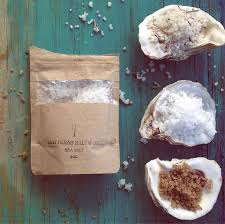I’m writing this on the Fourth of July, Independence Day, the day we celebrate our country’s birthday. Though for the first time in many years Jim and I are  not in Buxton to view the fireworks from the Avon Pier and Beach Club, we’re thinking about our life on Hatteras Island. What is gratifying to realize is that independence is what so many of our friends and neighbors have found there. Yes, many of us see the Island as a place where we can pursue our goals free of the usual encumbrances of city living: traffic, rigid work schedules and being cooped up away from the outdoors and friends to enjoy it with us. So my meeting with the delightful couple who are affectionately known as The Salt People stirred me to write about the unique life experience that led them through a sojourn in Hawaii and a brief return to their native state of New Jersey, and finally back home to Hatteras Island.
not in Buxton to view the fireworks from the Avon Pier and Beach Club, we’re thinking about our life on Hatteras Island. What is gratifying to realize is that independence is what so many of our friends and neighbors have found there. Yes, many of us see the Island as a place where we can pursue our goals free of the usual encumbrances of city living: traffic, rigid work schedules and being cooped up away from the outdoors and friends to enjoy it with us. So my meeting with the delightful couple who are affectionately known as The Salt People stirred me to write about the unique life experience that led them through a sojourn in Hawaii and a brief return to their native state of New Jersey, and finally back home to Hatteras Island.
Brian and Shaena McMahon first knew Hatteras Island around 2000 when Brian was stationed here with the Coast Guard. When his tour was up, he and Shaena decided to strike out for paradise in Hawaii. But they discovered to their dismay that those islands had their own traffic jams and long shopping lines, so they returned to the mainland and operated a power washing company in New Jersey. But it was their love of the sea that kindled their desire to come back to the uncrowded beach communities of Hatteras Island and start a new business. The Island proved a perfect place to raise their son and put to good use the life skills Brian and Shaena have gained working and traveling in their more than 20 years of marriage.
Brian reports that his interest in producing salt from sea water is not a new idea. “People were doing the same thing in the 1700s in the Caribbean Islands.” But what he found was that to use all natural ingredients (salt water collected from a pipe placed close to nearby Avon Pier and sun-powered kilns to separate the salt from the water) required Department of Agriculture approval and a close association with North Carolina State University, the go-to resource for much of the marine science studied on the Outer Banks. Brian‘s carpenter skills were put to work creating the standing kilns to dry the salt. He found that discarded sliding glass doors set on sturdy legs provide the perfect incubator for his salt production. The intense sun brings the kiln’s heat to about 190 degrees and at that temperature the source water is evaporated in 30 to 45 days, leaving the pure sea salt. And like father, like son: Brian’s son is working with him ‒ hammering, sweeping and studying the waters that bring the highly mineralized salt to the shores of Hatteras Island.
Meanwhile, Shaena addressed the marketing and packaging side of the business. She seized upon the idea of flavoring the salt with natural island products like the rosemary that grows on the salt works site, the former location of the Buxton community garden. The evaporator ovens dehydrate rosemary for blending with the natural salt. Pecan wood, another North Carolina product, adds a third flavor by infusing the sea salt with pecan wood flavoring in a cold smoker, a lengthy six-hour process. The time, effort and care that the McMahons invest in their products are clear when you savor that smoky nut flavor sprinkled on fresh cut peaches or the rosemary salt on a juicy steak.
So today the Hatteras Saltworks (www.hatterassaltworks.com) supplies 30 vendors from Hatteras Island to Norfolk, VA, and even in West Virginia and Raleigh. Packaged in handsome brown envelopes with hand stamped printing, the Hatteras Saltworks product is eye-catching as well as delicious. Look for it in many Hatteras Island stores. Jim and I sprinkled it on our Fourth of July watermelon while we thought of you all and treasured our life with the independent folks on Hatteras Island.
